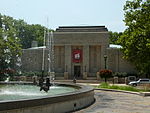Indiana University Bloomington
Indiana University Bloomington (IU Bloomington, Indiana University, IU, or simply Indiana) is a public research university in Bloomington, Indiana. It is the flagship campus of Indiana University and, with over 40,000 students, its largest campus.Indiana University is a member of the Association of American Universities and is classified among "R1: Doctoral Universities – Very high research activity". It has numerous schools and programs, including the Jacobs School of Music, the Luddy School of Informatics, Computing, and Engineering, the O'Neill School of Public and Environmental Affairs, the Kelley School of Business, the School of Public Health, the School of Nursing, the School of Optometry, the Maurer School of Law, the School of Education, the Media School, and the Hamilton Lugar School of Global and International Studies.The university is home to an extensive student life program, with more than 750 student organizations on campus and with around 17 percent of undergraduates joining the Greek system. Indiana athletic teams compete in Division I of the NCAA and are known as the Indiana Hoosiers. The university is a member of the Big Ten Conference; since it does not have a mascot, all teams are known simply as "Hoosiers". Indiana's faculty, staff, and alumni include nine Nobel laureates, 19 Rhodes Scholars, 17 Marshall Scholars, and five MacArthur Fellows. In addition, students and alumni have won six Academy Awards, 49 Grammy Awards, 32 Emmy Awards, 20 Pulitzer Prizes, four Tony Awards, and 95 Olympic medals (51 gold, 21 silver, and 23 bronze).
Excerpt from the Wikipedia article Indiana University Bloomington (License: CC BY-SA 3.0, Authors).Indiana University Bloomington
North Forrest Avenue, Bloomington
Geographical coordinates (GPS) Address Nearby Places Show on map
Geographical coordinates (GPS)
| Latitude | Longitude |
|---|---|
| N 39.167222 ° | E -86.521389 ° |
Address
North Forrest Avenue
North Forrest Avenue
47405 Bloomington
Indiana, United States
Open on Google Maps







